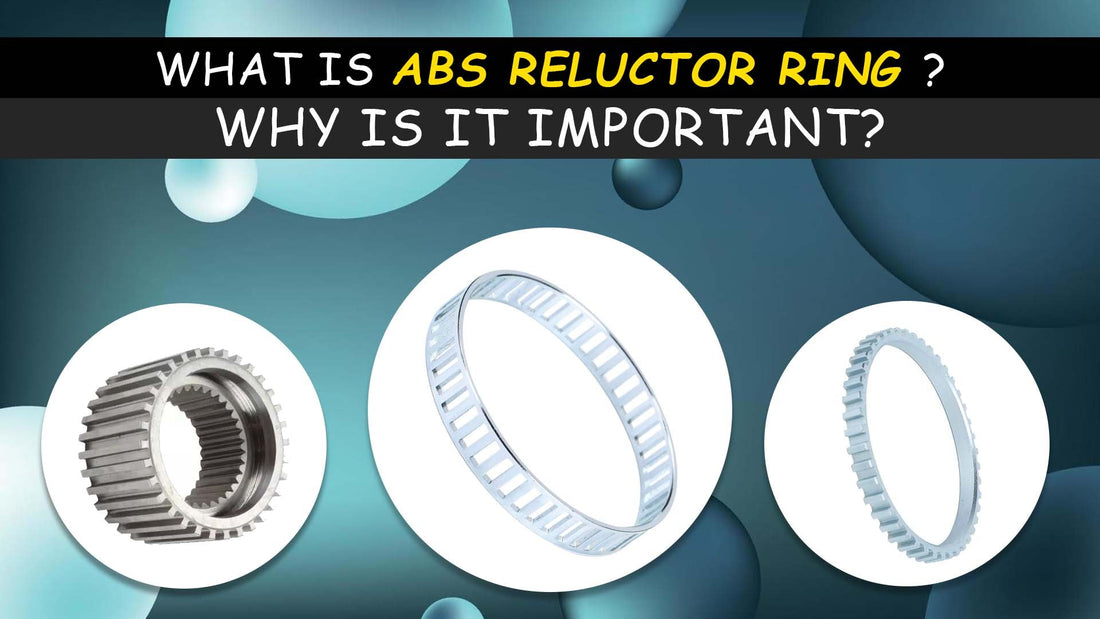
The Unsung Hero of Braking: Understanding ABS Reluctor Rings

Modern vehicles are marvels of engineering, packed with complex safety systems that work seamlessly in the background. Among the most critical is the Anti-lock Braking System (ABS), a feature we now take for granted, yet it relies on several components working in perfect harmony. At the heart of this system is the humble reluctor ring, also known as an ABS encoder ring or tone ring. This seemingly simple component, typically made from a robust ferrous material, is a crucial cog in the wheel speed monitoring mechanism, enabling precise braking performance and overall vehicle stability.
The ABS reluctor ring is precisely mounted to a rotating component of the wheel assembly, be it the driveshaft, hub, or even integrated into the wheel bearing itself. Its primary function is to interact with the wheel speed sensor to generate a series of electrical pulses which are proportional to the rotational speed of the wheel. These pulses are the language the ABS control unit understands, allowing it to discern when a wheel is about to lock up and to respond accordingly by modulating braking pressure. This is vital for maintaining steering control and minimising stopping distances during hard braking.
How it Works: More Than Just Teeth or Windows

Image by apecautomotive
The reluctor ring operates in tandem with a wheel speed sensor, typically a proximity or Hall effect sensor, positioned a small but precise distance away. As the wheel rotates, the sensor detects the change in the magnetic or electromagnetic field caused by the features of the reluctor ring, be they teeth or windows. This detection triggers the generation of an electrical pulse. The frequency of these pulses isn't the only thing that matters; the shape and consistency of the pulses can also impact the accuracy of the reading. A damaged or corroded ring can result in erratic or ‘noisy’ signals, potentially triggering ABS malfunctions.
The accuracy of the wheel speed signal also influences the efficacy of other driver assistance features such as Electronic Stability Control (ESC or ESP) and Traction Control (TCS). These systems rely on accurate wheel speed data to maintain stability, particularly on slippery or uneven surfaces. Any inaccuracies in the signal from the reluctor ring can compromise the performance of these vital safety features.
Diving Deeper: Toothed vs Windowed Designs
While both toothed and windowed designs achieve the same goal, there are subtle differences in their implementation and performance:
-
Toothed: These rings are characterised by their raised, tooth-like protrusions. The sensor measures the changes in magnetic flux as each tooth passes by. Variations in the shape and size of the teeth, as well as the spacing between them, can influence the accuracy and frequency of the signal being sent to the ABS ECU. The design is typically more resistant to contamination and damage from external debris due to its robust shape, and is often the preferred choice in applications where the components may be exposed to harsher environments. Additionally, the robust nature of the teeth makes them less prone to deformation than other types of rings.

-
Windowed: These rings feature precisely cut openings, or windows, around the circumference. As the wheel rotates, the sensor detects the presence and absence of the material. Windowed rings can sometimes be lighter than toothed versions, reducing unsprung weight slightly. The accuracy of the signal relies on the precise dimensions of the windows and their spacing. The smooth surface of windowed rings can sometimes be advantageous in terms of sensor life as they result in less wear on the sensor contact points. However, they can be more susceptible to signal degradation from contamination or damage to the integrity of the windows themselves.
The choice between these two designs often depends on the vehicle manufacturer's specific requirements and the operating conditions it is intended for. Both types of rings are typically made from hardened steel or other ferrous materials to withstand the rigours of everyday driving.
Common Issues

Images By slkworld & fq101
Despite their robust construction, reluctor rings are susceptible to several common problems that can impair their function:
-
Corrosion: Rust and corrosion, often caused by exposure to road salt and moisture, can weaken the ring and interfere with sensor readings.
-
Physical Damage: Impacts from road debris or tools can bend or break teeth on toothed rings or damage the windows on windowed rings, leading to inaccurate signals.
-
Cracking: Stress fractures can develop over time, especially in high-mileage vehicles, leading to signal loss.
-
Contamination: Dirt, grease, and brake dust can accumulate and interfere with the sensor's ability to read the ring correctly.
-
Incorrect Mounting: Improper installation can lead to misalignment and unreliable sensor readings.
-
Wear: Gradual wear over time can cause erosion of the teeth or window edges, resulting in signal loss or distortion.
These issues can lead to the ABS warning light activating on the dashboard, erratic ABS operation, reduced braking performance, and in some cases, a loss of stability control.
Troubleshooting and Maintenance
Image by: Brakeandfrontend
When a reluctor ring malfunctions, it can manifest in several ways. The ABS warning light illuminating is a common symptom. Other issues might include an erratic or spongy brake pedal, or even the complete failure of the ABS system. A diagnostic scan is often necessary to pinpoint the exact cause, but visual inspection of the rings can also be valuable.
Replacing a damaged reluctor ring usually requires dismantling part of the wheel assembly, often involving specialist tools. It's crucial to correctly fit and align the new ring to ensure that the sensor can properly read the speed data. It's highly recommended to consult a qualified technician for these tasks. Regular checks of your vehicles safety system can also help ensure it's working as intended and to spot any potential issue early.

Conclusion
It is a small, often overlooked component, but its role in ensuring the safe and reliable operation of the ABS system is paramount. It's a testament to the intricacies of modern automotive design, where even the smallest parts can have a huge impact on vehicle performance and safety. While we may not think about it often, the reluctor ring is a silent guardian, working tirelessly every time we brake to keep us safe on the road. If the ring on your vehicle is neither toothed nor windowed, it's possible you have a magnetic ABS ring, which works on a different principle.
No comments








0 comments